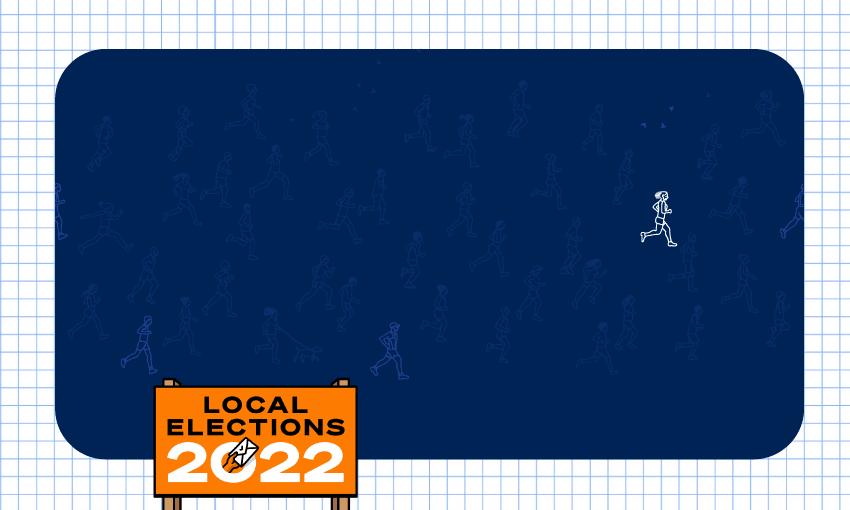New Zealand’s local body elections aren’t just afflicted by low voter turnout – there’s a low turnout of people standing as candidates too.
Local elections are a glorious gala of democracy: hundreds of elections taking place around the country. A shockingly high number of those, however, aren’t really elections at all. They’re races with a field of one. Unloseable. Across 572 elections three years ago, 101 were uncontested. That saw 235 candidates elected unopposed. The overall number of nominations relative to total available seats was the lowest on record. This time around, it could be worse still.
The local government association, LGNZ, has issued a late push for people to throw their names in the sparsely filled hats, ahead of nominations closing at noon on Friday.
“Many of our councils face the prospect of uncontested appointments, especially those outside of the big cities,” said Stuart Crosby, LGNZ president. The paucity of candidates was particularly pronounced in the South Island. Crosby pointed to the “sobering” example of the Mackenzie District Council, which to date has three nominations for a total of 19 vacancies.
Other councils where vacancies outnumbered candidates with a few days before nominations closed included the Otago Regional Council, Environment Southland, Queenstown Lakes District Council, Central Otago District Council, Nelson City Council, the Pōneke/Wellington constituency of the Wellington Regional Council, Rangitikei, South Waikato and Rotorua Lakes Council. The weekend came to an end with precisely zero candidates for the Timaru district mayoralty, but on Monday the incumbent Nigel Bowen entered the race – so far alone.
While there are hopes of a late surge in nominations, the last local body elections suggest there is a low turnout not just in voting, but in standing, too. As Ollie Neas observed in his Policy Local summary of 2019, there were one-candidate races for the mayoralties of Whangānui, Gore, Rangitīkei and Clutha. (In an effort to give him some kind of test, The Spinoff debated unopposed Whangānui mayoral hopeful Hamish McDouall.) Two sitting Auckland councillors gained their spots without facing a challenger. Across Southland District, 36 people won seats unchallenged, with two community board elections attracting no candidates at all.
Remarkably, the number of uncontested seats has tracked downwards over the last three elections but it is nevertheless “a real problem”, said Julienne Molineaux, a local elections expert and senior lecturer at AUT. In a scenario where, for example, six candidates stood for six seats and were accordingly automatically confirmed there would be no election at all and “they are not put under any scrutiny by the electorate”, she said. “The public does not have the opportunity to reject anyone, and, on the flipside, the winning candidates lack the legitimacy that comes from being voted into power by the public.”
A lack of candidates for the most senior positions could diminish interest in the elections more broadly, said Molineaux. She pointed to the example of Tony Kokshoorn, mayor of Grey District from 2004 to 2019. Well-regarded locally and nationally, he was elected unopposed in four elections. In 2013 and 2016, the turnout was under 39%. In 2019, four people stood for the role he was vacating, and the turnout leapt to over 63%. “If you have an exciting mayoral competition then people will vote, and most will vote down-ballot as well,” she said.
The lack of names in the hat is an important factor in the striking lack of broad representation in local body politics. The average age of elected members in 2019 was between 56 and 60. Only 14% of members were under the age of 40 – and that was a surge from 7% in 2016. About three times as many people 71 and older (12%) were elected as people 30 or younger (4%).
Local body representatives under 40
Women accounted for just over 40% of those elected, with numbers tending to be higher in urban areas. Successful candidates who identified as Māori were 13.5% of the total, up from 10% in 2016.
“It’s important that our council tables reflect the communities they represent,” said Lan Pham, co-chair of the LGNZ Young Elected Members Committee co-chair. Issuing an “SOS for local democracy”, she said she was “particularly concerned at the lack of nominations for councillors and community board members” and emphasised her own experience in 2016. “As a young female, I wasn’t sure if local government was the right environment for me, but my family and peers convinced me that I needed to give it a go. In the last two terms, I’ve been able to influence a number of decisions that have truly made Canterbury a better place for the next generation,” she said in a statement.
Proportion of elected women members
That was echoed by Bonita Bigham, chair of Te Maruata Roopu Whakahaere, the LGNZ group focused on Māori in in local government. “It is concerning that we are seeing such low numbers of nominations for community boards,” she said. A community board member’s workload was not as great as a councillor or mayor, but was “an equally important job” carrying considerable influence. The call for more Māori candidates is greater than ever with 32 Māori wards across Aotearoa.
Proportion of Māori elected members
Why were people not putting their hands up in bigger numbers? Disincentives identified included the time demanded, the pay and “ugly rhetoric directed at elected officials” said Crosby. He welcomed the recent change that scrapped the requirement for candidates to publicly list their home address, which “goes some way towards keeping candidates safe”.
A broader drop in willing candidates was likely linked to the drop in turnout, said Molineaux. On both counts, a diminution in local media coverage was part of the problem. “No one is going to my local board meetings and covering them any more, which they used to … Facebook has in some ways replaced that, with local information from your community. But no one from Facebook is turning up to the local board meeting. No one is casting an informed view … So people may just know these opportunities are there.”
The thin fields for local elections have been seized upon by Voices for Freedom, the anti-vaccine, anti-mandate, anti-mask group that was instrumental in the parliamentary grounds occupation and had 101 complaints against it upheld by the Advertising Standards Authority for releasing “misleading and socially irresponsible information about the Covid-19 pandemic”.
The lack of attention on local government elections, said one VFF organiser in a webinar for potential candidates, means “we can really sway the results, throw our weight around”. A mailout to supporters on Monday night devoted to the elections urged people to stand for community boards, which are “the most straightforward to get into as there are a large number of positions available and low levels of interest from the general public”.


